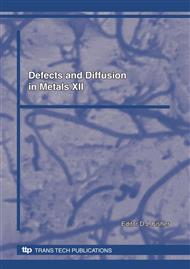[1]
T. Furusawa, A. Tsutsumi: Appl. Catalysis A Vol. 278 (2005), p.207.
Google Scholar
[2]
S. Takenaka, S. Sato, R. Takahashi, T. Sodesawa: Phys. Chem. Chem. Phys. Vol. 5 (2003), p.4968.
Google Scholar
[3]
A. Moronta, N. Iwasa, S.I. Fujita, M. Shimokawabe, M. Arai: Clays and Clay Minerals Vol. 53 (2005), p.622.
DOI: 10.1346/ccmn.2005.0530608
Google Scholar
[4]
V. Skvortsova, N. Mironova-Ulmane, U. Ulmanis: CIMTEC 2002- 3rd Forum on new materials 2nd International conference, P. Vincenzini, V. Buscaglia (Edited) Techna Srl. (2003), p.41.
Google Scholar
[5]
G. Lauhoff, C.A.F. Vaz, J.A.C. Bland: J. Phys. Condens. Matter Vol. 21 (2009), p.156002.
Google Scholar
[6]
S. Ramachandran, J. Narayan, J.T. Prater: Appl. Phys. Lett. Vol. 30 (2007), p.132511.
Google Scholar
[7]
S. Zhu, X. Xiang, X.T. Zu, L.M. Wang: Nucl. Instr. Meth. Phys. Res. B Vol. 242 (2006), p.114.
Google Scholar
[8]
H. Qiu, M. Hashimoto, A. Barna, P.B. Barna: Thin Solid Film Vol. 288 (1996), p.171.
Google Scholar
[9]
A. Schoenberg, J.T. Suss, Z. Luz, W. Low: Phys. Rev. B Vol. 9 (1974), p. (2047).
Google Scholar
[10]
U. Kaufmann: Phys. Rev. B Vol. 11 (1975), p.2478.
Google Scholar
[11]
I.E. Halliburton, N.C. Giles, P.G. Schunemann, T.M. Polak: J. Appl. Phys. Vol. 79 (1996), p.556.
Google Scholar
[12]
R. Alcalá, E. Zorita, P.J. Alonso: Phys. Rev. B 38 (1988), p.11156.
Google Scholar
[13]
A. Abragam, B. Bleaney: Electron Paramagnetic Resonance of Transition Ions (Oxford University Press, London 1970).
Google Scholar
[14]
B. Bleaney, K.D. Bowers, M.H.L. Pryce: Proc. R. Soc. London A Vol. 228 (1955), p.1645.
Google Scholar
[15]
P. Huang, P. Hu, M.G. Zhao: J. Phys. Chem. Solids Vol. 64 (2003), p.523.
Google Scholar
[16]
D.J. Newman, B. Ng: Rep. Prog. Phys. Vol. 52 (1989), p.699.
Google Scholar
[17]
A. Edgar: J. Phsy. C Vol. 9 (1976), p.4303.
Google Scholar
[18]
D.J. Newman, D.C. Pryce, W.A. Runciman: Am. Mineral. Vol. 63 (1978), p.1278.
Google Scholar
[19]
R.C. Weast: CRC Handbook of Chemistry and Physics (CRC Press, Boca Raton, 1989) p. B 196.
Google Scholar
[20]
B. Villacampa, R. Alcalá, P. J. Alonso: Phys. Rev. B Vol. 49 (1994), p.1039.
Google Scholar
[21]
K.H. Karlsson, T. Perander: Chem. Script. Vol. 3 (1973), p.201.
Google Scholar
[22]
M.M. Curtis, D.J. Newman: Chem. Phys. Lett. Vol. 9 (1971), p.606.
Google Scholar
[23]
J.S. Griffith: The Theory of Transition-Metal Ions (Cambridge University Press, London, 1964).
Google Scholar
[24]
Y.V. Yablokov, T.A. Ivanova: Coord. Chem. Rev. Vol. 190-192 (1999), p.1255.
Google Scholar
[25]
J.W. Orton, P. Auzins, J.H.E. Griffiths, J.E. Wertz: Proc. Phys. Soc. London Vol. 78 (1961), p.554.
Google Scholar


